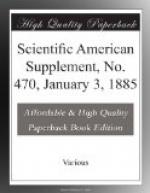The third year laboratory is designed for making commercial analyses. These latter are made by either dry or wet way. The first method employs water chiefly as a vehicle, and alkaline solutions as reagents. The second employs reagents in a dry state, and the action of which requires lamp and furnace heat. The furnaces employed in the new school are like those almost exclusively used industrially for the analysis of ores. The tables upon which analyses by dry way are made are large enough to allow sixteen pupils to work.
[Illustration: THE NEW CENTRAL SCHOOL AT PARIS.]
Analyses by wet way are made upon tables, with various sorts of vessels. Along with water, gas, and electricity, the pupils have at their disposal a faucet from whence they may draw the hydrosulphuric acid which is so constantly used in laboratory operations.
The architect of the new school is Mr. Denfer.
* * * * *
[NATURE.]
RESEARCHES ON THE ORIGIN AND LIFE-HISTORIES OF THE
LEAST AND LOWEST
LIVING THINGS.
By Rev. W.H. DALLINGER, LL. D.
To all who have familiarized themselves, even cursorily, with modern scientific knowledge, it is well known that the mind encounters the infinite in the contemplation of minute as well as in the study of vast natural phenomena. The farthest limit we have reached, with the most gigantic standard of measurement we could well employ, in gauging the greatness of the universe, only leaves us with an overwhelming consciousness of the awful greatness—the abyss of the infinite—that lies beyond, and which our minds can never measure. The indefinite has a limit somewhere; but it is not the indefinite, it is the measureless, the infinite, that vast extension forces upon our minds. In like manner, the immeasurable in minuteness is an inevitable mental sequence from the facts and phenomena revealed to us by a study of the minute in nature. The practical divisibility of matter disclosed by modern physics may well arrest and astonish us. But biology, the science which investigates the phenomena of all living things, is in this matter no whit behind. The most universally diffused organism in nature, the least in size with which we are definitely acquainted, is so small that fifty millions of them could lie together in the one-hundredth of an inch square. Yet these definite living things have the power of locomotion, of ingestion, of assimilation, of excretion, and of enormous multiplication, and the material of which the inconceivably minute living speck is made is a highly complex chemical compound. We dare not attempt a conception of the minuteness of the ultimate atoms that compose the several simple elements that thus mysteriously combine to form the complex substance and properties of this least and lowliest living thing. But if we could even measure these, as a mental necessity, we are urged indefinitely on




